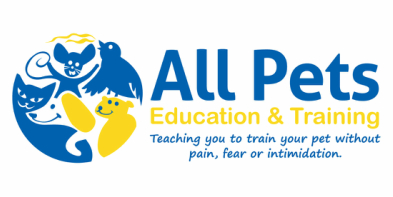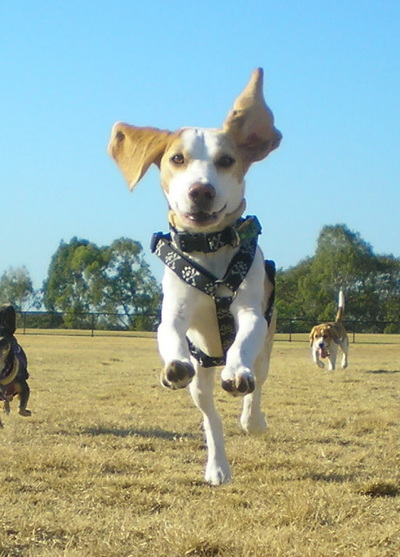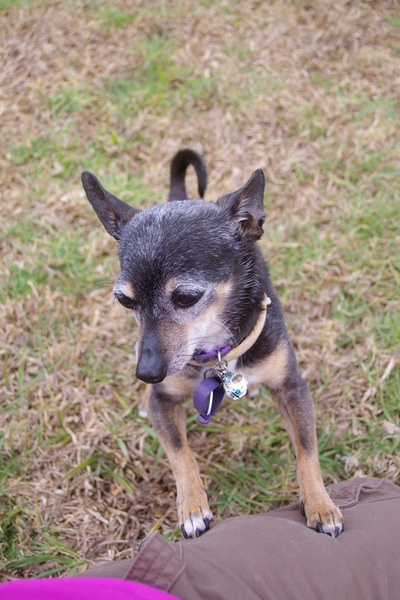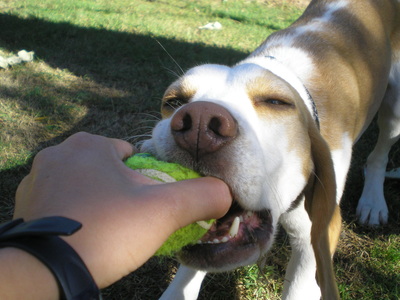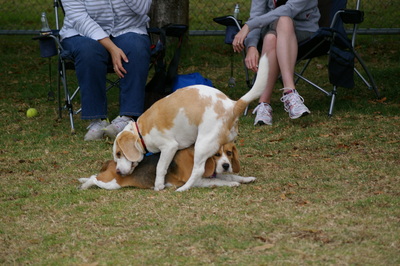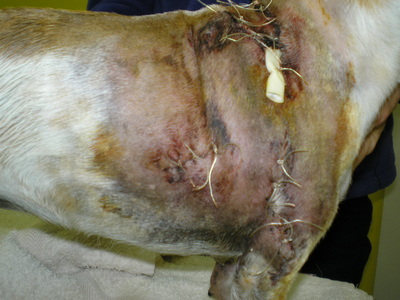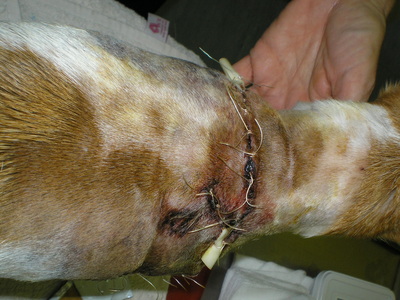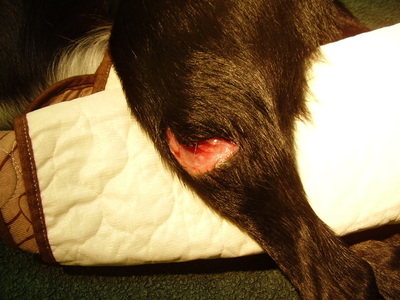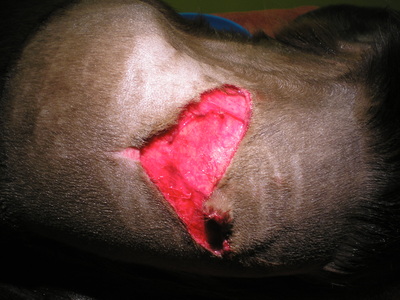Dog Parks
The Good, The Bad & The Ugly
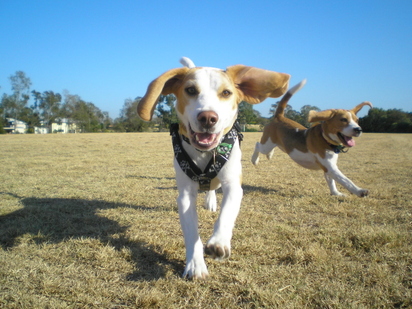
Everyone loves taking their dogs to dog parks … right? Why wouldn’t you? Your dog gets to romp and run, play and have fun with his or her friends.
But ask any dog trainer or veterinarian, and they will probably tell you that dog parks are not good news.
Because the truth is, there are both good and bad sides to dog parks.
The Good:
But ask any dog trainer or veterinarian, and they will probably tell you that dog parks are not good news.
Because the truth is, there are both good and bad sides to dog parks.
The Good:
- Most dog parks are fully enclosed and provide a “safe” place to exercise dogs.
- Social centre for the dog’s owner (this can also be bad as many owners may not supervise their pets).
- I will admit, I do use dog parks on rare occasions. However, I observe from the outside before entering, and will only enter if they are empty or when there are only a couple of well-mannered dogs. Usually I choose to walk on by, or practice some training and obedience near the park (using it as a distraction). If I do choose to enter, it is usually brief (5-10 minutes), to allow a quick run and sniff, and we leave as any others arrive. I prefer parks with two gates – as another dog enters, I can exit.
The Bad:
Bullies – dogs just like kids learn to be bullies. They may target one dog, and gang up as a group. They may chase, roll, and body slam the target dog. They may stand over it, intimidate it, bark at it, bite and nip at it. The more they practice this, the better they get at it too.
Fearful – your dog may be bullied. If you are not aware and ready to protect and remove your dog he may learn that he cannot rely on you to protect him. Not every dog, wants or needs to be every other dog’s friend.
Play can quickly escalate and the dogs may become over aroused and out of control. As the play becomes rougher, and more intense, the likelihood of a dog fight is greatly increased. Unfortunately, when a dog fight does occur, especially in a busy dog park, other dogs will join in. It quickly becomes a dangerous all in brawl.
And watch out for the humping dog (the humper). These dogs are actually often overstimulated or anxious dogs. It’s embarrassing for the dog’s owner and annoying for the owner of the humped dog (the humpee). Unfortunately although this is a normal behaviour, it is rude, and at some stage the humper will pick the wrong dog to hump. The humpee may turn and in anger/frustration/fear potentially bite the humper. More often than not though, the blame will be placed on the humpee.
Dogs will often learn, that “hey, without a lead, I don’t have to listen to you” and as a result learn learned disobedience.
Some dogs will resource guard favorite toys. If your dog loves tennis balls, and will get angry if another dog catches it, runs off with it or accidentally goes near it – don’t take the toy to the park (at least not if there are other dogs around).
Bullies – dogs just like kids learn to be bullies. They may target one dog, and gang up as a group. They may chase, roll, and body slam the target dog. They may stand over it, intimidate it, bark at it, bite and nip at it. The more they practice this, the better they get at it too.
Fearful – your dog may be bullied. If you are not aware and ready to protect and remove your dog he may learn that he cannot rely on you to protect him. Not every dog, wants or needs to be every other dog’s friend.
Play can quickly escalate and the dogs may become over aroused and out of control. As the play becomes rougher, and more intense, the likelihood of a dog fight is greatly increased. Unfortunately, when a dog fight does occur, especially in a busy dog park, other dogs will join in. It quickly becomes a dangerous all in brawl.
And watch out for the humping dog (the humper). These dogs are actually often overstimulated or anxious dogs. It’s embarrassing for the dog’s owner and annoying for the owner of the humped dog (the humpee). Unfortunately although this is a normal behaviour, it is rude, and at some stage the humper will pick the wrong dog to hump. The humpee may turn and in anger/frustration/fear potentially bite the humper. More often than not though, the blame will be placed on the humpee.
Dogs will often learn, that “hey, without a lead, I don’t have to listen to you” and as a result learn learned disobedience.
Some dogs will resource guard favorite toys. If your dog loves tennis balls, and will get angry if another dog catches it, runs off with it or accidentally goes near it – don’t take the toy to the park (at least not if there are other dogs around).
The Ugly:
Dog attacks are unfortunately not uncommon. Every veterinarian will have seen a number of cases where dogs have been involved in altercations. These can result in both physical and emotional injuries, and sometimes death.
Disease – dog parks are a central hub for disease.
Think about it – do you know the vaccination status of dogs that attend the park? Are they and your dog both adequately protected against Canine Parvovirus or Kennel Cough?
Not everyone picks up their dogs poo, and most dogs are probably not adequately wormed. Your dog will be at risk of worms, fleas, and viruses.
Dog attacks are unfortunately not uncommon. Every veterinarian will have seen a number of cases where dogs have been involved in altercations. These can result in both physical and emotional injuries, and sometimes death.
Disease – dog parks are a central hub for disease.
Think about it – do you know the vaccination status of dogs that attend the park? Are they and your dog both adequately protected against Canine Parvovirus or Kennel Cough?
Not everyone picks up their dogs poo, and most dogs are probably not adequately wormed. Your dog will be at risk of worms, fleas, and viruses.
Remember:
You are your dogs advocate. Be active in your observations and participation at the park. And remember, if you choose to take your dog to the dog park, you also acknowledge the associated risks.
References
ASPCA, (2015). Dog Parks. [online] Available at: https://www.aspca.org/pet-care/virtual-pet behaviorist/dog-behavior/dog-parks [Accessed 6 Feb. 2015].
Blake, M. (2008). The dog trainers resource 2. Wenatchee, Wash.: Dogwise Pub.
Heimbuch, J. (2013). 15 things humans do wrong at dog parks. [online] MNN - Mother Nature Network. Available at: http://www.mnn.com/family/pets/stories/15-things-humans-do-wrong-at-dog-parks [Accessed 6 Feb. 2015].
- Find as large a park as possible – the more space the less busy/crowded and less aroused the dogs will be.
- Check the entry/exit points for the park.
- Observe the other dogs in the park before taking in your dog.
- Ensure play partners are supervised, matched in size and play style. Interrupt and remove your dog if this is not the case.
- Promptly pick up your pooches poo – this means watching them 100% of the time.
- Watch your dog and those around it – be prepared to remove your dog from the park, before problems arise (even if your dog is not the instigator).
- Observe body language – is it play and are all parties happy? Don’t allow your dog to become a bully – remove him or her before she does.
- Watch the play style, interrupt play if necessary and take your dog for a short walk or do some calm touching to allow to calm down.
- Keep moving around the park – reward your dog for keeping an eye on you and especially when they check in.
- Wait 2 weeks after your dogs final puppy vaccination, before taking your dog to a dog park.
- Be aware that many dogs do not tolerate puppies. Keep them safe if you choose to use the park.
- Size match the dogs, and keep small and large dogs separate.
- If your dog is a resource guarder of a favorite toy – don’t take the toy to the park.
- If your dog is worried or frightened – remove them immediately from the park – don’t make them tough it out.
- If your dog has signs of any infectious disease or parasite burden – DO NOT take him/her to the park and put others at risk.
- OK, this may seem obvious – but… If you have a female dog, and she is in HEAT do not take her to the park. Seriously, people do.
You are your dogs advocate. Be active in your observations and participation at the park. And remember, if you choose to take your dog to the dog park, you also acknowledge the associated risks.
References
ASPCA, (2015). Dog Parks. [online] Available at: https://www.aspca.org/pet-care/virtual-pet behaviorist/dog-behavior/dog-parks [Accessed 6 Feb. 2015].
Blake, M. (2008). The dog trainers resource 2. Wenatchee, Wash.: Dogwise Pub.
Heimbuch, J. (2013). 15 things humans do wrong at dog parks. [online] MNN - Mother Nature Network. Available at: http://www.mnn.com/family/pets/stories/15-things-humans-do-wrong-at-dog-parks [Accessed 6 Feb. 2015].
